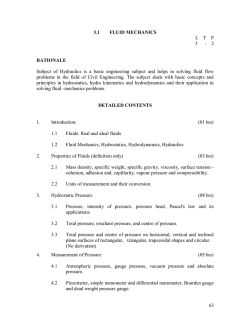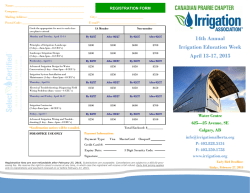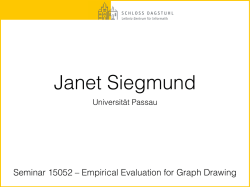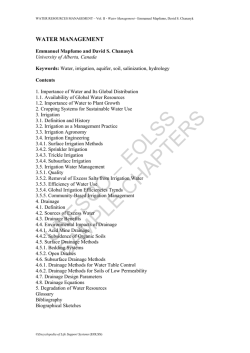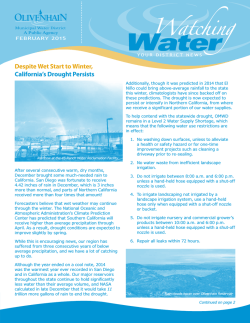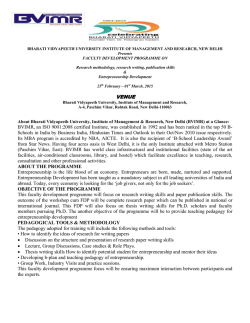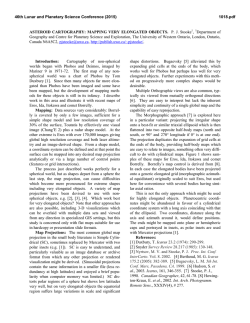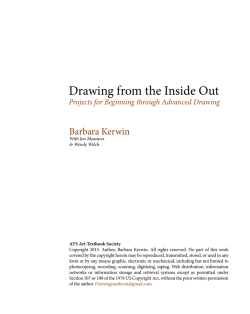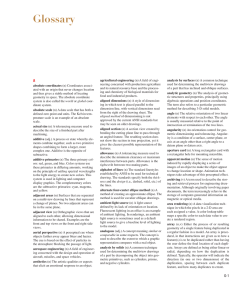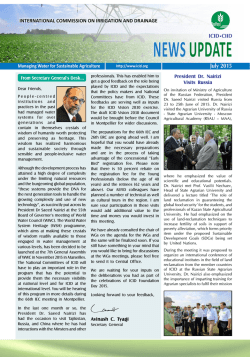
(Diploma Engineering) Civil
Diploma in Civil Programme Contents :- First Year Sr. No. 1 2 3 4 5 6 7 8 9 10 11 12 13 Name of Subject English-I Applied Mathematics Applied Physics Applied Chemistry Applied Mechanics Basics of Mechanical Engineering Engineering Drawing Concepts in Information Technology Workshop Technology – I Business Communication Study Through ICT* Technology Assignment Work Extra-Curricular Activities & Project Work Second Year Sr. No. 1 2 3 4 5 6 7 8 9 10 11 12 13 Name of Subject English-II Building Construction Civil /Architectural Engineering Drawing-I Concrete Technology Highway Engineering Transportation Engineering Surveying & Leveling-I Soil Mechanics & Foundation Engineering Design of RCC Structures Irrigation Engineering Study Through ICT* Technology Assignment Work Extra-Curricular Activities & Project Work Third Year Sr. No. 1 2 Page |1 Name of Subject English-III Surveying & Leveling - II 3 4 5 6 7 8 9 10 11 12 Design of Steel Structures Hydraulics & Hydraulic Machines Civil / Architecture Engineering Drawing - II Township & Urban Planning Earth Quake Engineering Entrepreneurship Development & Management Project Work Study Through ICT* Technology Assignment Work Extra-Curricular Activities & Project Work 1. Detailed syllabus: - First Year: First Year Sr. No. 1 2 3 4 5 6 7 8 9 10 11 12 13 Name of Subject English-I Applied Mathematics Applied Physics Applied Chemistry Applied Mechanics Basics of Mechanical Engineering Engineering Drawing Concepts in Information Technology Workshop Technology – I Business Communication Study Through ICT* Technology Assignment Work Extra-Curricular Activities & Project Work Subject Name: English-I 1. Functional Grammar: Patterns & Parts of speech Subject, Predicate, Noun, Pronoun, Adjective, Adverb, Verb, Verb phrases, Conjunction, Interjection. 2. Vocabulary: Word formation, Prefix, Suffix, Compound words, Conversion, Synonyms, Antonyms, Homophones and Homonyms, How to look up a dictionary. 3. Communication: Meaning & importance of communication, Barriers to effective communication, Channels of communication, Language as a tool of communication. 4. Requisites of Sentence writing: Fragmented sentences, A good sentence, expletives, Garbled sentences, Rambling sentences, Loaded sentences, Parallel Comparison, Squinting construction, Loose & periodic sentences. Subject Name: Applied Mathematics Page |2 1. Quadratic Equations 2. Arithmetic Progressions 3. Geometric Progressions 4. Partial Fractions 5. Permutations 6. Combinations 7. Binomial Theorem (For Positive Integral Index) 8. Binomial Theorem (For Fractional Index) 9. Measurement of Angles 10. Trigonometric Functions 11. Trigonometric Functions of Sum and Difference of Two Angles 12. Transformation Formulae 13. Trigonometric Functions of Multiple and Sub-Multiple Angles 14. Relations Between the Sides and the Trigonometric Ratios of the Angles of a Triangle 15. Area of a Triangle 16. Solution of Triangles 17. Cartesian Coordinates (Two Dimensions) 18. Locus 19. Straight Lines 20. Circles 21. Plotting of Curves 22. Translation of Axes 23. Parabolas 24. Ellipses 25. Hyperbolas 26. Polar Coordinates Subject Name: Applied Physics 1. Units and Dimensions: Fundamental and Derived Units in SI System, Dimensions of Physical Quantities, Principle of Homogeneity Dimensional Equation, Applications of Dimensional Analysis: Checking the Correctness of Physical Equations, Derivation of Simple Physical Relations, Limitation of Dimensional Analysis, Significant Figures and Error Analysis. 2. Force and Motion: Scalars and Vectors, Velocity & acceleration, Equations of Motion, Newton’s Law of Motion, Force & its Derivation from Newton’s Laws of Motion, Composition and resolution of forces, Parabolic Motion Horizontal Projection and Projection at an angle, Time of Flight, Horizontal Range and Maximum Horizontal Range, Simple Problems, Centripetal Acceleration, Centripetal and Centrifugal Forces, Concept of Friction and its Application, Application to Banking of roads. 3. Work, Power and Energy: Work and its Units, Work Done on Bodies Moving on Horizontal and Inclined Planes (Consider Frictional Forces Also). Concept of Power and its Units, Calculations of Power (Simple Cases), Concept of Kinetic Energy and Potential Energy Expressions for P.E and K.E, Conservation of Energy in the Case of Freely Falling Bodies, Principle of Conservation of Energy. 4. Rotational and Simple Harmonic Motions: Definition of Moment of Inertia, Moment of Inertia of Disc, Ring, & Sphere, Torque and Angular Momentum and Their Inter Relation, Principles of Conservation Page |3 (Angular Momentum and its Applications). Kinetic Energy of Rolling Body, S.H.M – Derivation of Displacement, Velocity, Acceleration, Time Period and Frequency, Motion of Cantilever, Free, Forced and Resonant Vibrations (No Derivation). 5. Heat- Temperature and its Measurement: Concept of Heat and Temperature on the Basis of K.E. of Molecules, Unit of Heat Basic Principles of Measurement of Temperature, Thermocouple, Bimetallic and Resistance, Pyrometers and Thermometers Criteria for the Selection of Thermometers. 6. Expansion of Solids: Coefficient of Linear, Surface and Cubical Expansions and Relation Amongst Them, Thermal Stresses (Qualitative Only) and their Applications. 7. Heat Transfer: Three Modes of Transfer of Heat, Coefficient of Thermal Conductivity, its Determination by Searle’s Method and Lee’s Disc Method, Conduction Through Compound Media (Series and Parallel for Two Materials Only), Heat Radiation, Characteristics of Heat Radiations, Prevost’s Theory of Heat Exchange, Black Body Radiations, Emissivity and Absorptivity Kirchhoff’s Law and Stefan’s Law of Radiation. Subject Name: Applied Chemistry 1. Structure of Atom: Chemistry as Important Branch of Science, Basic Concept of Elements Mixture and Compound, Chemical Equation, its Balancing, Implications and Limitations, Recapitulation of Fundamental Particles of Atom i.e., Electron, Proton and Neutron, Bohr’s Model of Atom, Line Spectrum of Hydrogen, Modern Concept of Atom-Four Quantum Numbers, Shells, Subshells, Orbital (Shapes of s & p Orbital), Pauli’s Exclusion Principle, Aufbau Energy Ranking Rule, Orbital Concept Types of bonds co-valency, formation of s-s, s-p, p-p, bonding with examples, Hybridization sp, sp2, sp3, (Consider BeF2, BF3, CH4) molecules, Brief Concept of Modern Periodic Table of Elements. 2. Chemical Equation, Oxidation & Reduction: Concept of Oxidation & Reduction, Electronic Concept of Oxidation & Reduction, Redox Reactions (Direct and Indirect), Oxidation Number Balancing of Simple Redox Reactions by Oxidation Number. 3. Ionic Equilibrium: Ionization, Degree of Ionization, Focus Effecting Ionization, Ionization of Water, Ionization Equilibrium in Aqueous Solutions, Common Ion Effect. 4. Acids and Bases: Concept of Acids and Bases, Their Strength in Ionization Constant, PH Value, Acid Base Titration, Choice of Indicators, Hydrolysis, Buffer Solution. 5. Electrolysis: Concept of Electrolysis, Faraday’s Law of Electrolysis, Engineering Applications (ElectroMetallurgy, Electroplating & Electro-Refining) 6. Water: Hard and Soft Water, Removal of Hardness by: Soda Lime Process, Permutit’s Process, Ion Exchange Method., Disadvantages of Hard Water in Industrial User, Boiler Scales, Priming, Foaming Corrosion and Caustic Embrittlement, Expressing the Degree of Hardness of Water in (With Simple Problems): Clark’s Degree, O’ Hener’s Method, Determination of Degree of Hardness by (With Simple Problems): Soap Titration Method, O’ Hener’s Method: Water for Drinking Purposes. 7. Solutions & Colloids: Solute, Solvent, Solution & Colloids, Particle Size and Colloidal State, Tyndell Effect, Brownian Movement, Coagulation. Subject Name: Applied Mechanics Page |4 1. Introduction: Concept of Mechanics and Applied Mechanics, Explanation of Mechanics and Applied Mechanics, Its Importance and Necessity, Giving Suitable Examples on Bodies at Rest and in Motion, Explanation of Branches of this Subject, Concept of Rigid Bodies. 2. Laws of Forces: Force and its Effects, Units and Measurement of Force, Characteristics of Force Vector Representation, Bow’s Notation, Types of Forces, Action and Reaction, Tension, Thrust and Shear Force, Force Systems: Coplanar and Space Force Systems, Coplanar Concurrent and Non-Concurrent Forces, Free Body Diagrams, Resultant and Components Concept of Equilibrium, Parallelogram Law of Forces, Equilibrium of Two Forces, Superposition and Transmissibility of Forces, Newton’s Third Law, Triangle of Forces, Different Cases of Concurrent Coplanar, Two Force Systems, Extension of Parallelogram Law and Triangle Law to Many Forces Acting at One Point-Polygon Law of Forces, Method of Resolution into Orthogonal Components for Finding the Resultant, Graphical Methods, Special Case of Three Concurrent, Coplanar Forces, Lami’s Theorem. 3. Moments: Concept of Moment, Varigon’s Theorem- Statement Only, Principle of Moments- Application of Moments to Simple Mechanism, Parallel Forces, Calculation of their Resultant, Concept of Couple Properties and Effect, Moving a Force Parallel to its Line of Action, General Cases of Coplanar Force System, General Conditions of Equilibrium of Bodies Under Coplanar Forces. 4. Friction: Concept of Friction, Laws of Friction, Limiting Friction and Coefficient of Friction, Sliding Friction. 5. Centre of Gravity: Concept of Gravity, Gravitational Force, Centroid and Center of Gravity, Centroid for Regular Lamina and Center of Gravity for Regular Solids, Position of Center of Gravity of Compound Bodies and Centroid of Composition Area, CG of Bodies with Portions Removed. 6. Laws of Motion: Concept of Momentum, Newton’s Laws of Motion, Their Application, Derivation of Force Equation from Second Law of Motion, Numerical Problems on Second Law of Motion, Piles, Lifts, Bodies Tied with String, Newton’s Third Law of Motion and Numerical Problems Based on it, Conservation of Momentum, Impulsive Force (Definition Only). 7. Simple Machines: Concept of Machine, Mechanical Advantage, Velocity Ratio and Efficiency of a Machine, their Relationship, Law of Machine, Simple Machines (Lever, Wheel and Axle, Pulleys, Jacks Winch Crabs Only). Subject Name: Basics of Mechanical Engineering 1. 2. 3. 4. 5. 6. 7. 8. 9. Source of Energy: Introduction, Types of Energy. Steam and its Properties: Introduction to Steam, Terms Related to Steam Formation. Boiler: Classification of Boilers, Merits and Demerits, Boiler Mounting. Prime Movers: Definition of Prime Movers, Impulse and Reaction Turbines, Open and Close Cycle Gas Turbine. Internal Combustion Engines: Heat Engine, External and Internal Combustion Engine, Classification of IC Engines, Principle Parts of IC Engines. Refrigeration and Air Conditioning: Types of Refrigeration System, VCRS, Air Conditioning. Welding, Soldering and Brazing: Welding, Classification of Plastic and Fussion Welding, Arc Welding, Types of Electrode, Brazing and Soldering. Machine Tools: Introduction, Classification of Lathes, Major Parts of a Lathe, Specification of Lathe, Drilling Machine Operations, Milling and Down Milling, Grinding Machines. Lubrication and Bearings: Introduction to Lubrication, Function and Properties of Lubricants Classification of Bearings. Page |5 10. Power Transmission: Belt Drives, Belt Material, Gear Train, Types of Gears, Compound Gear Train. 11. Mechatronics: Concept of Mechatronics System, Elements of Measurement System, Types of Control Systems, Microprocessor Based Controllers. Subject Name: Engineering Drawing 1. 2. 3. 4. 5. 6. Drawing Office Practice: Importance of Engineering Drawing, Importance of Legible Lettering and Numbering, Dimensioning, Scales, Geometrical Construction, Conics, Geometric Curves. Orthographic Projections, Projection of Simple Objects in three views. Projection of Solids and Section of Solids: Projection of Simple Solids, Sectional View. Pictorial Drawing: Isometric Drawings. Development of Surfaces. Practice on AutoCAD: AutoCAD Commands, Exercise. Subject Name: Concepts in Information Technology 1. Information Concepts & Processing: Definition of Information, Data VS Information, Introduction to Information System, Information Representation Digital Media, Images, Graphics, Animation, Audio, Video etc. Need a Value & Quality of Information the concept of Information entropy & Numerical. 2. Computer Appreciation: Definition of electronic Computer, History, Generation, Characteristics & Application of Computers, Classification of Computers, RAM, ROM, Computer Hardware, CPU, Various I/O Devices, Peripherals, Storage Media, Software Definition and Concepts. 3. Data Communication & Networks: Computer Networks, Networking of Computers, Introduction to LAN, WAN, MAN, Network Topologies, Basic Concepts in Computer Networks, Introduction to GPRS, CDMA, GSM & FM Technologies. 4. Introduction to Internet Technologies: HTML, DHTML, WWW, FTP, TELNET, Web Browser, Net Surfing, Search Engines, E-Mail, ISP, E-Commerce, Public Key, Private Key, Safety of Business Transaction on Web. 5. Concepts in Operating System: Elementary Concepts in Operating System, GUI, Introduction to DOS, MS Windows. Subject Name: Workshop Technology 1. Carpentry and Painting Shop: Introduction to Wood Work, Preparation of Dovetail Joint, Preparation of Mitre Joint, Preparation of Lengthening Joint etc… 2. Fitting Shop: Drill, Taps and Dies, Using a Hand Tap, Care and Maintenance of Measuring Tools, Height Gauge, Files, Preparation of Job Involving Threads, Using a Pipe Threading Set, Care of Pipe Cutters and Threading Sets. 3. Welding Shop: Gas Welding, Operation and Maintenance of Oxygas Equipment, Equipment Setup, Maintaining the Equipment, Oxygas Welding Techniques, Common Welding Joints Generally Made by Gas Welding, Proper Edge Preparation and Fit Up, Welding Procedure. 4. Electric Shop: Importance of Three Phase Wiring and Its Effectiveness, Two-Wattmeter Method of Power Measurement in a Three Phase Circuit, Connecting Single Energy Meter and testing it, Reading and Working out the Power and costing of Energy in a Single Phase Circuit. Page |6 5. Electronic Shop: Wire Rope, Various Types of Plugs, Sockets, Connectors Suitable for General Purpose Audio Video Use, Demonstrate the skill to make Facilities Solder Joint, Installation and Soldering of Printed Circuit Components, Soldering of PCB Components, Application of Solder and Soldering Iron Tip. Subject Name: Business Communication 1. 2. 3. 4. 5. 6. 7. Corresponding: (Official, Business and Personal): One Letter from Each Category. Grammar: Tenses, Narration, Punctuation. Essay. Reports. Notices. Note-Making and Summarizing. Business Correspondence. Second Year Second Year Sr. No. 1 2 3 4 5 6 7 8 9 10 11 12 13 Name of Subject English-II Building Construction Civil /Architectural Engineering Drawing-I Concrete Technology Highway Engineering Transportation Engineering Surveying & Leveling-I Soil Mechanics & Foundation Engineering Design of RCC Structures Irrigation Engineering Study Through ICT* Technology Assignment Work Extra-Curricular Activities & Project Work Subject Name: English-II 1. Functional Grammar: Articles, Preposition, Tenses: Functions, Synthesis, Transformation, Spotting errors and correction of sentences. 2. Pre- Requisites of Technical written Communication: One word substitution, Spelling rules, Words often confused & misused, Phrases. 3. The Structure of sentences/ clauses: Adverb clause, Adjective clause, Noun clause. Sentences: Simple, Double, Multiple and complex, Transformation of sentences: simple to complex & vice versa, simple to compound & vice-versa, Interrogative to assertive & to negative & vice-versa. 4. Technical Communication: Nature, Origin and Development, Salient features, Scope & Significance, Forms of Technical Communication, Difference between Technical Communication & General writing, Objective Style vs. Literary Composition. Page |7 Subject Name: Building Construction 1. Foundation: Purpose, shallow & deep foundation, Sketches for spread footing & isolated column footing. 2. Plinth: Plinth filling material and their representation. Introduction to load & R.C.C. frame structure including beams, column, slab, chaijja, lintel etc. with their general size and placements. 3. Carpentry Joints: Meaning of term, technical terms, classification etc. 4. Floor: Purpose, mezzanine floor, stilt floor, basement floor (introduction only). 5. Lintels: Purpose, types, general size, terminology. 6. Arches: Purpose, types & applications. 7. Brick masonry: English bond, Flemish bond, precautions to be taken in bonding, king closer, queen closer, bat and application. 8. Stone Masonry: Rubble masonry, Ashlar masonry, introduction to artificial stone and uses, stone finishes. 9. Door and Windows: Types of door & windows with their applications. 10. Structures in Brick Work: Footing, Piers, etc. Subject Name: Civil/Architecture Engineering Drawing – I 1. Basic Concepts of Drawing : Introduction, requirements of Good Drawing, Role of Presentation, Lines and Line Work, Drawing Instrument and Aids, Line Work and Lettering, Original Drawing, Scale Dimensioning Engineering Drawing, Lettering [ is 9609 (part 0): 2001 and sp46 : 2003]. 2. Construction of Geometric Figures: The Construction of Geometric Figures Given Data, The Triangle, The Quadrilateral, Polygons, The Construction of Circle to Satisfy Given Condition. 3. Projections : Introduction, 3-D Projections, Multi-view Projections, Working Drawings, Orthographic Projections, Types of Projection, First angle Projection, Third Angle Projection, Projection of Points, Projection of Lines, The Blending of Lines and Curves, Conic Section-The Ellipse, The Parabola, the Hyperbola, The Ellipse, the Parabola, The Hyperbola. 4. Basic Concepts of Drawing : Introduction, Prisms, Pyramids, Solids of Revolution , Frustums and truncated solids, Prisms, Reference Planes, Pyramids, Application of Orthographies Projections, Fillet Curve. 5. Isometric Projection: Isometric Projection, Freehand Sketching. 6. Further Problem: Further Problems, Areas of Irregular Shapes. Subject Name: Concrete Technology 1. Concrete : Concrete as a Structural Material, Good Concrete Manufacture of Portland Cement, Chemical Composition of Cement, Hydration of Cement, Heat of Hydration and Strength, Tests on Cement and Cement Paste- Fineness, Consistency, Setting Time, Soundness, Strength. 2. Portland Cement: Types of Portland Cement Ordinary, Rapid Hardening, Low-heat, Sulphate Resisting, Portland Slag, Portland Pozzolana, Super Sulphate Cement, White Cement. 3. Aggregates : Classification, Mechanical and physical Properties, Deleterious Substance, Alkali-Aggregate Reaction, Sieve Analysis, grading Curves, Fineness Modules, grading requirements. Testing of Aggregates Flakiness, Elongation Tests, Aggregate Crushing Value, Impact Value and Abrasion Value. 4. Properties of Fresh Concrete : Workability, Factors Affecting Workability, Slump Test Compacting Factors Test, Kelly Ball Test, Flow Table Test, Segregation, Bleeding, Setting Time, Mixing and Vibration of Concrete, Methods, Maturity. Page |8 5. Strength of Concrete : Water/ Cement ratio, Gel/Space ratio, Strength in Tension, Compression, Effect of Age on Strength, Relation Between Compressive and Tensile Strength, Fatigue Strength, Shrinkage and Creep, Compression Test on Cubes, Cylinders, Non-Destructive Tests. 6. Admixtures: Different Types of Admixtures, Effects, User, Retarders and Super Plasticizers. Subject Name: Highway Engineering 1. Highway Planning: An Overview: History of roads Transport, Nagpur, Bombay and Lucknow Plan, Highway Classification, Administration of Roads, Financing Roads Survey, route Design Surveys and Selection of Highway Alignment, Drainage Studies, Soil Survey, highway Project Report Preparation. 2. Geometric Design : Road User Characteristics, Vehicle Characteristics, Function Classification of Roads, Topography, Design Speed, Traffic Volume, Composition and Capacity of Road, CrossSection ofa road, Horizontal Curves, Sight Distance, Intersections. 3. Pavement Material : Soils, Soil Compaction, Aggregate, Pavement Courses, Types of Binders,, Bitumen's, Cement concrete for Pavement, Concrete Mix Design. 4. Pavement Design: Types of Pavement, Desirable Properties of Pavements, Flexible and rigid Pavement, Factors Influencing Design, Methods of Pavement Design, Temperature and other Stresses, Design of Joint Plain Concrete Slabs, Overlay Design for Flexible and Rigid Pavement. 5. Construction and Maintenance of Roads : Embankment construction, Compaction, Construction Equipment, Soil Stabilization, Construction Methods, Granular Sub-Base and Bases, Open Textured Carpet, Dense bituminous Concrete, Highway Maintenance. Subject Name: Transportation Engineering 1. Introduction to Transportation Engineering: Introduction to Transportation, Formation of Settlements, Mode of Transportation, Basic Premise of a Transportation System, Major Disciplines of Transportation. 2. Geometric Design and Transportation Planning: Geometric Design, road Classification, Width of Pavement of Carriageway, Transport Planning, The urban Transportation Planning Process (UTPP), Trip Generation. 3. Traffic Management: Regulation of Traffic, Public Transport, Count Data Processing, Distribution, Poisson distribution, Normal Distribution, Linear Regression, Road Accident Scenario, Factors Causing Accidents, Prevention of Accidents, Cost of Road Accidents, Parking Traffic Signals and Traffic Signs. 4. Pavement Design, Construction and Maintenance of Road: Pavement Design, Road Construction, Soil Stabilization, highway Maintenance, Maintenance System. 5. Transport Economic and Other Modes of Transportation Engineering: Transport Demand and Supply, Cost of Producing Transport Services, Pricing of Transport Services, Methods of Economic Analysis, Role of Railways, An Overview of Air Transportation, Rapidly changing Technology Water Transportation. Subject Name: Surveying & Leveling-I 1. Introduction: Surveying and Leveling, Objects of Surveying, Uses of Surveying, Classification of Surveying, General Principles of Surveying, Stages of Survey Operation, Scale, Types of Scale, Type of Vernier. Page |9 2. Chain Surveying: Introduction, Methods of Direct Measurements, Instruments used for Chaining, Ranging of Line, Testing and Adjustment of Chain, Degree of Accuracy in chaining, Methods of Chaining on slopping ground, chain and tape corrections, obstacles in chaining, solved examples, Errors in chaining, Electronic distance measurements, Geodimeter, Tellurometer, 3. Chain Triangulation: Introduction, Terms related to chain triangulation, Equipment for chain surveying, Field Book, Field Work, Instruments for setting out right angles, Conventional Symbols. 4. Compass Surveying: Introduction, Traversing, Principle of Compass surveying, basic definitions, calculation of included angles from bearing, calculation of bearings from included angles. 5. Plane Table Surveying: Principle of plane table survey, Instruments required for plane table survey, Temporary Adjustments of Plane table, Methods of Plane table surveying, Advantages and disadvantages of plane table survey. 6. Levelling: Object of leveling, uses of leveling, Basic definitions, Instruments used, Temporary adjustments of level, classification of leveling. 7. Theodolite: Introduction, Types of theodolite, Size of theodolite, Basic Definition, Some modern theodolites, The fundamentals lines of theodolite. Subject Name: Soil Mechanics & Foundation Engineering 1. Nature of Soil: Problems with soil, Phase relation in soil, Classification for engineering purpose, Soil Compaction, Field compaction methods and monitoring. 2. Soil water and water Flow: Soil water, Influence of Clay minerals, Effective stress Concepts in Soil, Darcy's law Permeability measurement in the laboratory, introduction to flow nets. 3. Stress Distribution in Soil: Stress Distribution, Westergaard's Solution, Compression and Consolidation of Soils, Normally Consolidated and Over-Consolidated clays, Analysis of Consolidation-Terzaghi's theory. 4. Shear Strength of Cohesive : Shear strength of Cohesive and Cohesion less soils, Mohr Coulomb failure theory, Measurement of shear strength, Direct shear, tri axial Compression, Drained and Untrained Behaviors of Clay and sand, Stress path for Conventional Triaxial test. 5. Slope Stability: Slope failure Mechanisms, total and effective stress analysis, Stability analysis for purely cohesive and C soils, Method of Slices, Taylor’s Stability number, slope Protection Measures. 6. Foundation: Well Foundation or Caisson Foundation, Machine Foundation, Loads in Foundation, Bearing Capacity of the Soil, Causes of Failures of Foundations, Requirement of Good Foundations. Subject Name: Design of RCC Structures 1. Details of reinforcement in a simply supported RCC beam (singly reinforced and doubly reinforced) with the given design data regarding the size and number of bars, stirrups their size and spacing. 2. Details of reinforcement for a RCC square and circular column with isolated square footing. 3. Details of reinforcement for a cantilever beam with given data regarding the size of the beam and the reinforcement. 4. Details of reinforcement in plan and section for a simply supported RCC one way slab with intermediate support and two-way slabs from the given data. Bar bending schedule should be prepared. P a g e | 10 5. Details of reinforcement in a two storeyed RCC internal and corner column. In this, the details of reinforcement at the junction with beams must be shown from the given design data. 6. Details of reinforcement of the junction of a secondary beam with the main beam with the given data. Subject Name: Irrigation Engineering 1. Introduction of Irrigation: Definition, Necessity and Scope of Irrigation, Multipurpose River Valley Project, Benefits of Irrigation, Ill-Effects if Irrigation, History of Irrigation. 2. Methods of Irrigation: Modes or Methods of Applying water to crops, Uncontrolled or Wild Flooding, Free Flooding, Flooding by Contour Laterals, Border strip Flooding Method, Check flooding, Ring Basin Flooding, Zigzag and Furrow methods, Drip Irrigation. 3. Water Requirement of Crops: functions and Quality of Irrigation water, Types of Soils, Classes and Availability of Soil Water, Principal Crops and Crop Seasons, Duty and Delta, factors Affecting Duty, Soil Fertility Crop Rotation. 4. Ground Water: Well Irrigation: Definition of Aquiculture and Aquifuge, Divisions of Sub-Surface Water, Types of Aruifers, Tube Wells Other Sources of Under Ground Water. 5. DAMS: According to hydraulic Design, According to Material, Gravity Dams, Arch Dams, Buttress Dams, Timber Dams, Earth and Rock fill Dams, Selection of Site for a Dam. 6. Flow Irrigation: Canals Classification, Canal Alignment, Curves, Inundation Canals, Bandhara Irrigation. 7. Water Logging: Effects of Water Logging, causes of water logging, Remedial Measures, losser in Canal, Land Drainage. 8. River Engineering: Classification of River, Meandering, Causes of Meandering, the Aggrading Type of river, Cut off, River Training. 9. Water Resources Planning: India's Water Resources, Scenario of Water Use, Purpose of Water Resource Development Classification of Water Resource Development Projects, Strategies for the Future, Planning Strategies, Management Strategies. Third Year Third Year Sr. No. 1 2 3 4 5 6 7 8 9 10 11 12 Name of Subject English-III Surveying & Leveling - II Design of Steel Structures Hydraulics & Hydraulic Machines Civil / Architecture Engineering Drawing - II Township & Urban Planning Earth Quake Engineering Entrepreneurship Development & Management Project Work Study Through ICT* Technology Assignment Work Extra-Curricular Activities & Project Work Subject Name: English-III P a g e | 11 1. The Seven C’s of the Effective Communication: Completeness, Conciseness, Consideration, Concreteness, Clarity, Courtesy, Correctness. 2. Communication: Its interpretation: Basics, Nonverbal Communication, Barriers to Communication. 3. Business Communication at Work Place: Letter Components and Layouts, Planning a letter, Process of Letter writing, Email Communication, Memo and Memo Reports, Employment Communication, Notice Agenda and Minutes of Meeting, Brochures. 4. Report Writing: Effective Writing, Types of Business Reports, Structure of Reports, Gathering Information, Organization of the Material, Writing Abstracts and Summaries, Writing Definitions, Visual Aids, User Instruction Manual. 5. Required Skills: Reading Skills, Note-making, Précis Writing, Audio Visual Aids, Oral Communication. 6. Mechanics of Writing: Transitions, Spelling Rules, Hyphenation, Transcribing Numbers, Abbreviating Technical and Non-Technical Terms, Proof Reading. Subject Name: Surveying & Leveling -II 1. Contouring: Concepts of Contours, Purpose of Contouring, Contour interval and Horizontal equivalent, factors effecting contour interval characteristics of Contours, Drawing Cross section from a Contour map: Marking alignment of a road, railway and a canal on contour map, Computation of earth work and reservoir Capacity from a Contour map. 2. Theodolite Surveying: Working of a transit venire axes of a theodolite and their relation; temporary adjustments of a transit theodolite; Concept of transiting, swinging, face left, face right and Changing face; plotting a traverse; concept of coordinate and solution of omitted Measurements (one side affected), error in theodolite survey and Precautions taken to minimize Them; Limit of Precision in theodolite traversing. 3. Techno-metric Surveying: Tachometry, Instruments to be used in tachometry, methods of tachometry, stadia system of tachometry, general principle of stadia tachometry, examples of stadia Tachometry. 4. Curve: Introduction, why we study Minor Instrument? Abney Level, Testing of Abney Level, Adjustment of Abney Level, Testing of Tangent clinometers, Tracing or Laying the Grade contour, Measuring a Slope, Pantographs, reducing a plane, Advantage of Box Sextant, Zero Circle. 5. Aerial Surveying: Introduction, Why we do Aerial Surveying, Photographic Surveying, Question for Self Evaluation. Subject Name: Design of Steel Structures Units 1: Railway Engineering 1. 2. 3. 4. 5. 6. 7. Introduction Permanent Way Rails Sleepers Ballasts Fixtures and fastenings Track Geometrics P a g e | 12 8. 9. 10. 11. 12. Points and Crossing Track Construction Railways Stations and Yards Signaling and Interlocking Track Maintenance Unit 2: Bridge Engineering 13. 14. 15. 16. 17. 18. 19. 20. Introduction Site Selection and Investigation Bridge Foundations Piers, Abutments, Wing Walls & Approaches Bridge Bearing Temporary Bridge Permanent Bridge Bridge Construction and Maintenance Unit 3: Tunnel Engineering 21. 22. 23. 24. Introduction Tunnel Investigations and Surveying Tunneling and Lining Ventilation and Drainage of Tunnels Subject Name: Hydraulics and Hydraulic Machines 1. Introduction: Fluid: Real Fluid, Ideal Fluid, Fluid Mechanics, Hydraulics, Hydrostatics, Hydrokinematics and Hydrodynamics. 2. Properties of Fluids: Mass Density, Specific Weight, Specific Gravity, Cohesion, Adhesion, Viscosity, Surface Tension, Capillary, Vapour Pressure and Compressibility, Units of Measurement. 3. Hydrostatic Pressure: Pressure, Intensity of Pressure, Pressure Head, Pascal's Law and its Applications, Total Pressure, Resultant Pressure, and Center of Pressure, Total Pressure and Center of Pressure on Vertical and Inclined Plane Surfaces: Rectangular, Triangular, Trapezoidal, Circular, Total Pressure on Dams and Lock Gates. 4. Measurement of Pressure: Atmospheric Pressure, Gauge Pressure, Vacuum Pressure and Absolute Pressure, Piezometers, Simple Manometer, Different Manometer and Mechanical Gauges, Measurement of Pressure by Manometers and Pressure Gauges. 5. Fundamentals of Fluid Flow: Types of Flow: Steady and Unsteady Flow, Laminar and Turbulent Flow, Uniform and Non Uniform Flow, Discharge and Continuity Equation (Flow Equation), Types of Hydraulic Energy: Potential Energy, Kinetic Energy, Pressure Energy, Bernoulli's Theorem: Statement and Description (without Proof of Theorem). 6. Orifice: Definition of Orifice, and Types of Orifice, Hydraulic Coefficients, Large Vertical Orifices and Small Orifices, Free Drowned and Partially Drowned Orifice, Time of Emptying a Rectangular/Circular Tanks with Flat Bottom. P a g e | 13 7. Flow Through Pipes: Definition, Laminar and Turbulent Flow, Explain Through Reynolds Experiment, Reynolds Number, Critical Velocity and Velocity Distribution, Head Lose in Pipelines Due to Friction, Sudden Expansion and Sudden Contraction, Entrance, Exit, Obstruction and Change of Direction (No Derivation of Formulae), Flow From One Reservoir to Another Through Long Pipe of Uniform and Composite Section, Water Hammer Phenomenon and its Effects (Only Elementary Treatment), Pipes in Series and Parallel, Syphon. 8. Flow Through Open Channels: Definition of a Channel, Uniform Flow and Open Channel Flow, Discharge Through Channels Using: (a) Chezy's Formulae (No Derivation), (b) Manning's Formulae, Most Economical Sections: (a) Rectangular, (b) Trapezoidal, (c) Circular. 9. Flow Measurements: Measurement of Velocity by Pitot-Tube, Current Meter, Surface Float, Velocity Rods, Measurement of Discharge by a Notch: (a) Difference between Notches and Orifices, (b) Discharge Formulae for Rectangular Notch, Triangular Notch, Trapezoidal Notch and Conditions for their use (No Derivation), Measurement of Discharge by Weirs: (a) Difference between Notch and Weir, (b) Discharge Formulae for Free Drowned and Broad Crested Weir With and Without end Contraction, Velocity of Approach and Condition of Their Use, (c) Venturi Fumes to Measure Flow, Measurement of Discharge by Velocity Area- Method. 10. Hydraulic Machines: Reciprocating Pumps, Centrifugal Pumps, Impulse Turbines, Reaction Turbines, Sketching and Description of Principles of Working of Above Mentioned Machines. Subject Name: Civil / Architecture Engineering Drawing - II 1. 2. 3. 4. 5. 6. 7. 8. 9. 10. Introduction Sanitary Engineering Surface Drains & Sewers Traps, Manholes & Inspection Chamber Septic Tanks & Soak Pits House Drainage & Sanity Fittings Irrigation Engineering Wells& Tube Wells Canals Irrigation Outlets, falls and Cross Drainage Works Subject Name: Township & Urban Planning 1. Town Planning Principles: General -Evolution of planning-objects of town planning-Economic justification for town planning-Principles of Town Planning - Necessity of town planning -Origin of towns - growth of towns - stages in town development-personality of town - Distribution of land uses-Forms of Planning-site for an ideal Town-requirement of new Towns-Planning of the modern Town-Power required for enforce T.P schemes - Cost of town planning - Present Position of Town Planning in India. 2. Planning of Buildings: Principles of Architectural Planning and Design, Function/Utility, Form, Planning for Utility and aesthetics, Submission drawings, Working Drawings. Planning concepts of Green buildings, Eco Friendly and Cost effective building, rain Harvesting Systems. P a g e | 14 3. Housing: General- Importance of Housing-Demand for Houses-Building site-requirement of Residential Buildings-Classification of residential buildings-Design of residential Areas-rural Housing- Agencies for Housing-Investment in housing-HUDCO-CIDCO- Housing problem in India. 4. Planning of Residential Building -I: Bungalows, Row houses, Ownership Flats and Apartments: Elevation, Detailed Sections, Staircase, calculation of Built-up area. 5. Public Building : General , Location of Public Building, Classification of Public building, principles of Design of Public Building, Town Centres, Grouping of Public -Civic aesthetics. 6. Urban Roads : General- object- Requirement of good city, Road-factors to be Considered-Classification of Urban Road-Types of Street System-Through and By-pass roads-outer and Inner ring roadsExpress ways-Freeways-Precincts-Road aesthetics. 7. Building Bye- Law : General objects of bye-law-Importance of Bye-Law-function of local authorityresponsibility of owner-Applicability of bye-laws-set-back-light, plane-floor, Space index-off-street, Parking-fire Protection-Minimum Lot Sizes -Some other terms-principle underlying building bye-lawsbuilding bye-laws for residential area of a typical town planning scheme-building bye-laws-development control rules-general rules of Metropolitan Ares-CMDA rules. Subject Name: Earth Quake Engineering 1. An Integrated Earth System: Gravity and the Lithosphere, Introduction to the Hydrosphere. 2. The Solid Earth: Earth Formation and Structure, Geologic time Scale, the Lithosphere and Plate Tectonics, Geological Disturbances, Earth Internal Structure, Major Features of The Continents, The tides, Tidal Forcing. 3. Geological Materials: Description of Materials, Description and Classification of Soils and Rocks, Soil and Rock Description, Water -Rock Interaction. 4. Earthquake Engineering : Introduction, Causes of Earthquake and Faulting, Measurement of Earthquakes, Seismic Hazards In India, Earthquake Hazards in the North Eastern Region, Strong Ground motion and Fault Rupture, Main shock and Aftershocks, Observed Records, Surface Fault Trace, fault rupture Model, Strong Motion Simulations, Frequency of Earthquake, Earthquake Resistant Structure. 5. Landslides: Landslides, Land Subsidence, Expansive Soils. 6. Geophysical Mapping of History Cemeteries: Application for geophysics in cemetery, other Application Concerns, Geophysical well logging, The Borehole Environment, radioactive Methods, Conclusions, Problem, Limitation. 7. Seismic Design of Building: Earthquake-Their Cause and Effect, Lateral Force resisting Systems, Types of Building and typical Earthquake Performance. 8. Tsunami: Physical Characteristics of Tsunami, Mitigation of Risks and Hazards, Prediction and Early warning, Tsunami Safety Rules. Subject Name: Entrepreneurship Development and Management 1. Entrepreneurship: Definition of Entrepreneur, Internal and External factors, Functions of an Entrepreneurship Motivation and Barriers, Classification of Entrepreneurship, Theory of Entrepreneurship, Concept of Entrepreneurship, Development of Entrepreneurship. P a g e | 15 2. Creativity and Entrepreneurial plan: Idea Generation, Screening and Project Identification, Creative Performance Feasibility Analysis: Economic, Marketing financial and Technical; Project planning: Evaluation, Monitoring and Control, Value analysis, Innovation. 3. International Entrepreneurship opportunities: The nature of international Entrepreneurship, Importance if international business to the Firm, International Versus domestics' Entrepreneurship, Stages of Economic Development. Institutional Support for new Ventures : Supporting Organization; Incentives and facilities; Financial institutions and small scale Industrial, Govt. Polices for SSLs. 4. Family and non-family Entrepreneur: Role of Professionals, Professionalism vs Family Entrepreneurs, Role of Woman Entrepreneur. 5. Venture Capital: Venture Capital, Nature and Overview, Venture Capital Process, Locating Venture Capitalists. Note:The Normal Rule and Regulation pertaining to the Examination and other issues will be applicable in Faculty of Engineering & Technology as per Arunachal University of Studies Act 2012, Subsequent Statute and Rules & Regulations P a g e | 16
© Copyright 2025
